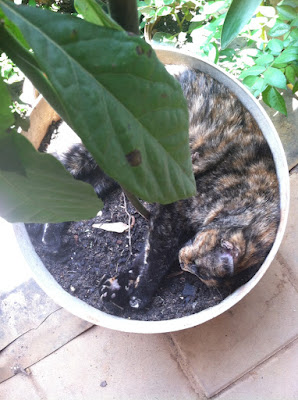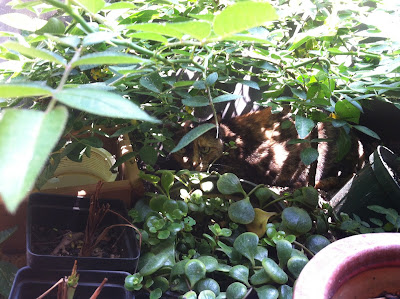We ended up losing the plant shortly after these pictures. But here a couple pictures of our attempt to grow a Watermelon (Citrullus lanatus) - better luck next year I hope.
Saturday, June 27, 2015
Watermelon Seedling (Citrullus lanatus)
Tuesday, June 23, 2015
Importance of Soil pH
Soil pH is a measure of the soil's acidity or alkalinity measured on a scale of 0 to 14, with 7 being considered neutral (neither acidic nor alkaline). Moving down the scale closer to 0 (zero), the pH is considered more acidic. Moving up the scale closer to 14, the pH is considered more alkaline. In simple terms, the closer to zero you go, the closer to battery acid you get and the closer to 14 you go the closer to drain cleaner you get.
As a basic reference the following chart is a good example of common items and their lcoation on the pH scale:
There are more graphic examples out there - but you get the idea.
So why is this important for your plants? Soil pH directly affects nutrient availability and the toxicity of minerals to your plants. Aluminum and manganese become more available in acidic soils, while calcium, phosphorous, and magnesium are less available. In alkaline soils, phosphorous and most micro-nutrients become less available. Depending on what nutrients your plants require and in what quantities will determine the optimal soil pH level.
Most plants prefer a relatively neutral soil pH (between 6.0 and 7.5, approximately). Some plants do thrive in acidic conditions (pH of 4.5 to 6.5) and some in alkaline conditions (pH of 7.5 to 8.0). The Old Farmer's Almanac has a good listing of plants and their preferred pH ranges.
As a basic reference the following chart is a good example of common items and their lcoation on the pH scale:
There are more graphic examples out there - but you get the idea.
So why is this important for your plants? Soil pH directly affects nutrient availability and the toxicity of minerals to your plants. Aluminum and manganese become more available in acidic soils, while calcium, phosphorous, and magnesium are less available. In alkaline soils, phosphorous and most micro-nutrients become less available. Depending on what nutrients your plants require and in what quantities will determine the optimal soil pH level.
Most plants prefer a relatively neutral soil pH (between 6.0 and 7.5, approximately). Some plants do thrive in acidic conditions (pH of 4.5 to 6.5) and some in alkaline conditions (pH of 7.5 to 8.0). The Old Farmer's Almanac has a good listing of plants and their preferred pH ranges.
Labels:
acidic,
alkaline,
pH,
soil conditions,
soil PH
Monday, June 22, 2015
Passion Flower (Passiflora)
Passion Flower or passion vine is an edible vine that can grow up to 20 feet high. The leaves and stems can be dried (or used fresh) and used to make herbal teas, the flowers can be eaten in salads, and the fruit is tasty all by itself and makes wonderful jams and jellies.
The plant is said to be an herbal remedy for anxiety and insomnia. It's also really pretty compared to many other herbs.
The Passion Flower pictures below are from our yard and are a Passiflora Incarnata commonly referred to as a Maypop or Purple Passionflower. We have two plants that sprang up in our yard this summer.
The plant is said to be an herbal remedy for anxiety and insomnia. It's also really pretty compared to many other herbs.
The Passion Flower pictures below are from our yard and are a Passiflora Incarnata commonly referred to as a Maypop or Purple Passionflower. We have two plants that sprang up in our yard this summer.
Monday, June 8, 2015
Blueberries
The Blueberry bushes are producing, a small crop but very delicious. We just planted them this spring, hopefully they will produce more in the coming years as they become more established.
Monday, June 1, 2015
Subscribe to:
Comments (Atom)

















